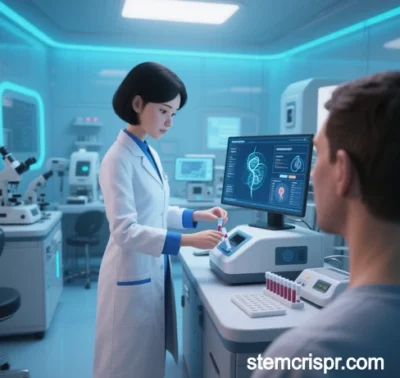
Core Applications of Stem CRISPR Technology in Ex Vivo Therapy and Organ Regeneration
Definition and Fundamentals of Stem CRISPR Technology
CRISPR (Clustered Regularly Interspaced Short Palindromic Repeats) is an adaptive immune system derived from bacteria and archaea. It enables precise gene editing through the synergistic action of Cas proteins and single-guide RNA (sgRNA). The core mechanisms include three stages:
- Adaptive Immunity: Cas proteins recognize and cleave invading foreign DNA fragments (spacers), integrating them into the host CRISPR locus.
- Expression: The CRISPR array is transcribed into precursor crRNA, processed into mature crRNA-tracrRNA complexes that guide Cas proteins to target DNA.
- Interference: Nucleases like Cas9 or Cpf1, guided by crRNA, recognize specific DNA sequences (requiring a PAM sequence), induce double-strand breaks (DSBs), and enable gene knockout, knock-in, or repair via non-homologous end joining (NHEJ) or homology-directed repair (HDR).
Advantages Over Traditional Gene-Editing Tools (e.g., ZFNs, TALENs):
- High Efficiency: Editing efficiency exceeds 79% with multi-gene targeting capability.
- Simplicity: Requires only sgRNA design, bypassing complex protein engineering.
- Cost-Effectiveness: sgRNA synthesis is cheaper than traditional nuclease development.
- Versatility: Base editing (BE), prime editing (PE), and dCas9-based gene regulation (CRISPRa/i) expand applications.
Limitations: Off-target effects, inefficient delivery systems, and HDR dependency on cell cycle phases.
Core Applications in Ex Vivo Therapy
Ex vivo therapy involves extracting patient cells for in vitro gene editing before reinfusion. Key features include:
- Target Cells: Hematopoietic stem cells (HSPCs), T cells, and other blood cells due to ease of manipulation.
- Standardized Workflow: Cell isolation, culture, editing, quality control, and reinfusion.
- Safety: Avoids immune risks associated with in vivo delivery vectors.
Case Studies:
- Sickle Cell Disease & Beta-Thalassemia:
- Casgevy Therapy: CRISPR-mediated knockout of BCL11A in HSPCs reactivates fetal hemoglobin (HbF), reducing vaso-occlusive crises. Approved in the U.S. and EU, clinical trials show >90% of patients transfusion-free.
- Lyfgenia Therapy: Lentiviral delivery of anti-sickling hemoglobin genes complements CRISPR-based approaches.
- Cancer Immunotherapy:
- CAR-T Cell Engineering: CRISPR knockout of PD-1 or TCR genes (e.g., TRAC/TRBC) enhances tumor-killing. Clinical trials for non-small cell lung cancer have entered Phase I.
- HIV Treatment: CCR5 gene knockout in T cells achieves functional cure in select cases.
- Genetic Skin Disorders:
- Epidermolysis Bullosa: Editing COL7A1 defects in patient fibroblasts for skin graft regeneration.
Challenges:
- Limited applicability to complex organ cells (e.g., neurons, cardiomyocytes).
- Transient survival of edited cells (e.g., T cells) necessitates repeated treatments.
Breakthroughs and Challenges in Organ Regeneration
Organ regeneration combines stem cell differentiation, biomaterial scaffolds, and CRISPR editing to rebuild functional tissues. Key directions:
- Stem Cell Differentiation:
- Liver Regeneration: CRISPR-corrected iPSCs differentiate into hepatocytes, restoring liver function in animal models.
- Cardiac Repair: CRISPR-activated GATA4 and 3D-printed cardiac patches improve heart function in clinical trials.
- Bioengineered Organs:
- Liver Models: Organoid-hydrogel hybrids mimic drug metabolism for toxicity screening.
- Vascular Bioprinting: CRISPR-edited endothelial cells promote vascularization in regenerated organs.
- In Situ Regeneration:
- Muscle Repair: CRISPR correction of dystrophin mutations in DMD models restores 60% muscle strength in canine studies.
- Cartilage Regeneration: CRISPRi suppression of IL-1β enhances MSC chondrogenesis for osteoarthritis therapy.
Technical Hurdles:
- Replicating organ-specific 3D architecture (e.g., liver hepatocytes, cholangiocytes).
- Functional integration with host neural/vascular systems (<30% success rate).
- Immune rejection of allogeneic cells or biomaterials.
Future Directions
- Precision Editing: Prime Editors (PE4/PE5) minimize off-target effects.
- Delivery Systems: Enhanced nanoparticles or AAV vectors improve editing efficiency.
- Organoid Models: CRISPR-edited organoids accelerate personalized disease modeling.
- Ethics & Regulation: Global standards needed for germline editing boundaries.
Conclusion
Stem CRISPR technology demonstrates transformative potential in ex vivo therapy (e.g., blood disorders, cancer) and organ regeneration (e.g., liver, muscle). Despite challenges like off-target effects and delivery bottlenecks, advancements in base editing and biomaterials promise clinical breakthroughs. Interdisciplinary collaboration and robust regulatory frameworks will ensure safe, scalable applications.
Data sourced from publicly available references. For collaborations or domain inquiries, contact: chuanchuan810@gmail.com.




